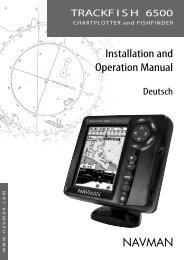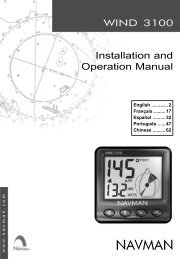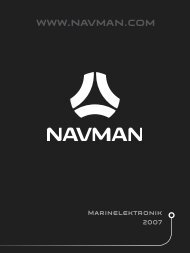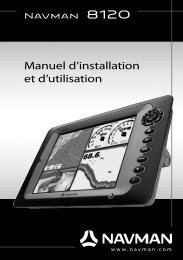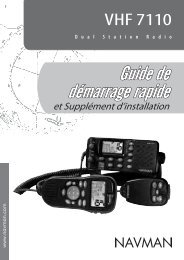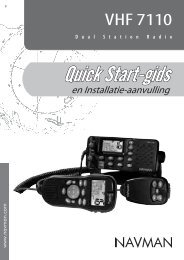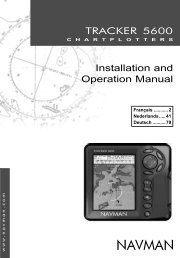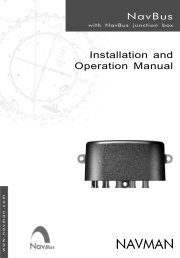English - Navman Marine
English - Navman Marine
English - Navman Marine
You also want an ePaper? Increase the reach of your titles
YUMPU automatically turns print PDFs into web optimized ePapers that Google loves.
Fish arches<br />
In good conditions and with Fish symbols Off,<br />
a Þ sh passing through the cone-shaped ultrasonic<br />
pulse is displayed as a Þ sh arch.<br />
A Þsh arch occurs when a Þsh enters the weak<br />
edge of the sonar cone, generating a weak echo<br />
that is displayed as the Þrst pixel of the Þsh arch.<br />
As the Þsh moves closer to the middle of the<br />
cone, the distance between the transducer and<br />
the Þsh reduces and the echo is displayed at<br />
progressively shallower depths, producing the<br />
start of an arch. When the Þsh passes directly beneath<br />
the middle of the cone, the echo becomes<br />
strongest and thickest. As the Þsh passes out of<br />
the middle of the cone the reverse happens with<br />
a progressively weaker and deeper echo.<br />
There are many reasons why Þsh arches may<br />
not be seen. For example:<br />
• Poor transducer installation (see Transom<br />
Transducers Installation Guide).<br />
• If the boat is anchored then Þsh will tend to<br />
show on the display as horizontal lines as<br />
they swim into and out of the transducer<br />
sonar beam. Slow speeds in deeper water<br />
give the best Þsh arch returns.<br />
• Range is important. It will be much easier<br />
to see Þsh arches when using zoom mode<br />
to concentrate on a particular section of<br />
water, rather than just displaying everything<br />
from the surface to the bottom. Zooming<br />
increases screen resolution up to 100 times.<br />
• It is difÞcult to get Þsh arches in shallow<br />
water as the transducer sonar beam is very<br />
narrow near the surface and Þsh do not stay<br />
within the beam long enough to display an<br />
arch. Several Þsh in shallow water tend to<br />
display as randomly stacked blocks of pixels.<br />
• Wave motion may result in distorted fish<br />
arches.<br />
4-3 Gain<br />
Gain (sensitivity) controls the amount of detail<br />
displayed on the FISH 4350 and FISH 4380.<br />
Understanding how to set suitable Gain settings<br />
is important for optimum performance.<br />
The <strong>Navman</strong> Þ shÞ nder has two gain modes,<br />
Auto Gain and Manual Gain. Normally the<br />
best results are obtained in Manual Gain, but<br />
practice and experience are required to obtain<br />
the optimum settings for different conditions.<br />
Therefore, the use of Auto Gain is strongly<br />
recommended when learning to use the<br />
Þ shÞ nder or when travelling at speed.<br />
• In Auto Gain, the gain adjusts<br />
automatically to compensate for water<br />
depth and clarity.<br />
• In Manual Gain, the gain can be adjusted<br />
by the user to compensate for water<br />
depth and clarity.<br />
High Gain settings may amplify the normal background<br />
noise until it appears as random pixels.<br />
Changing between Auto and Manual<br />
To change between Auto Gain and Manual<br />
Gain:<br />
1. From any Sonar display, press .<br />
2. Use the cursor key to select Auto or<br />
Manual.<br />
Adjusting Gain settings<br />
1. From any Sonar display, press .<br />
2. Use the or cursor keys to change the<br />
gain.<br />
Note: The Gain mode<br />
automatically changes<br />
to Manual Gain if the<br />
gain setting is adjusted<br />
by the user.<br />
Obtaining the best<br />
results<br />
To obtain the best<br />
detection capability for<br />
both fish and bottom<br />
we recommend the<br />
user adjusts the gain in the A-Scope display<br />
until the threshold line is just to the right of the<br />
unwanted noise:<br />
Gain<br />
Threshold<br />
line<br />
Unwanted<br />
signal<br />
Gain line<br />
FISH 4350 / 4380 Installation and Operation Manual NAVMAN<br />
17




